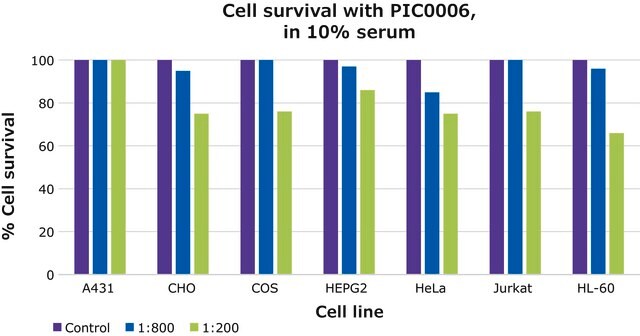539133
Protease Inhibitor Cocktail VI
liquid, for the inhibition of proteases and esterases. This small molecule/inhibitor is primarily used for Protease Inhibitors applications.
Synonym(e):
Protease inhibitor cocktail
About This Item
Empfohlene Produkte
product name
Protease Inhibitor Cocktail Set VI, The Protease Inhibitor Cocktail Set VI controls the activity of Protease. This small molecule/inhibitor is primarily used for Protease Inhibitors applications.
Form
liquid
Hersteller/Markenname
Calbiochem®
Lagerbedingungen
OK to freeze
Versandbedingung
wet ice
Lagertemp.
−20°C
Allgemeine Beschreibung
This cocktail is provided as a single vial of 1 ml, or as a package of 5 x 1 ml vials. Each vial contains the inhibitors solubilized in DMSO at the following concentrations:
Spezifität
Biochem./physiol. Wirkung
Aspartic, cysteine, serine, and metalloproteases as well as aminopeptidases.
Warnhinweis
Physikalische Form
Rechtliche Hinweise
Signalwort
Danger
H-Sätze
Gefahreneinstufungen
Acute Tox. 4 Oral - Aquatic Acute 1 - Aquatic Chronic 1 - Eye Dam. 1 - Skin Irrit. 2
Lagerklassenschlüssel
10 - Combustible liquids
WGK
WGK 3
Flammpunkt (°F)
188.6 °F
Flammpunkt (°C)
87 °C
Analysenzertifikate (COA)
Suchen Sie nach Analysenzertifikate (COA), indem Sie die Lot-/Chargennummer des Produkts eingeben. Lot- und Chargennummern sind auf dem Produktetikett hinter den Wörtern ‘Lot’ oder ‘Batch’ (Lot oder Charge) zu finden.
Besitzen Sie dieses Produkt bereits?
In der Dokumentenbibliothek finden Sie die Dokumentation zu den Produkten, die Sie kürzlich erworben haben.
Unser Team von Wissenschaftlern verfügt über Erfahrung in allen Forschungsbereichen einschließlich Life Science, Materialwissenschaften, chemischer Synthese, Chromatographie, Analytik und vielen mehr..
Setzen Sie sich mit dem technischen Dienst in Verbindung.










